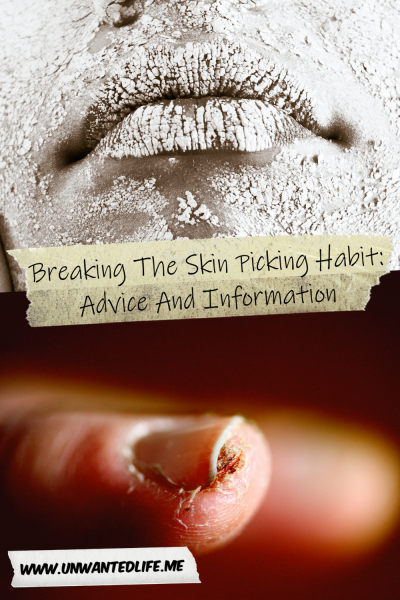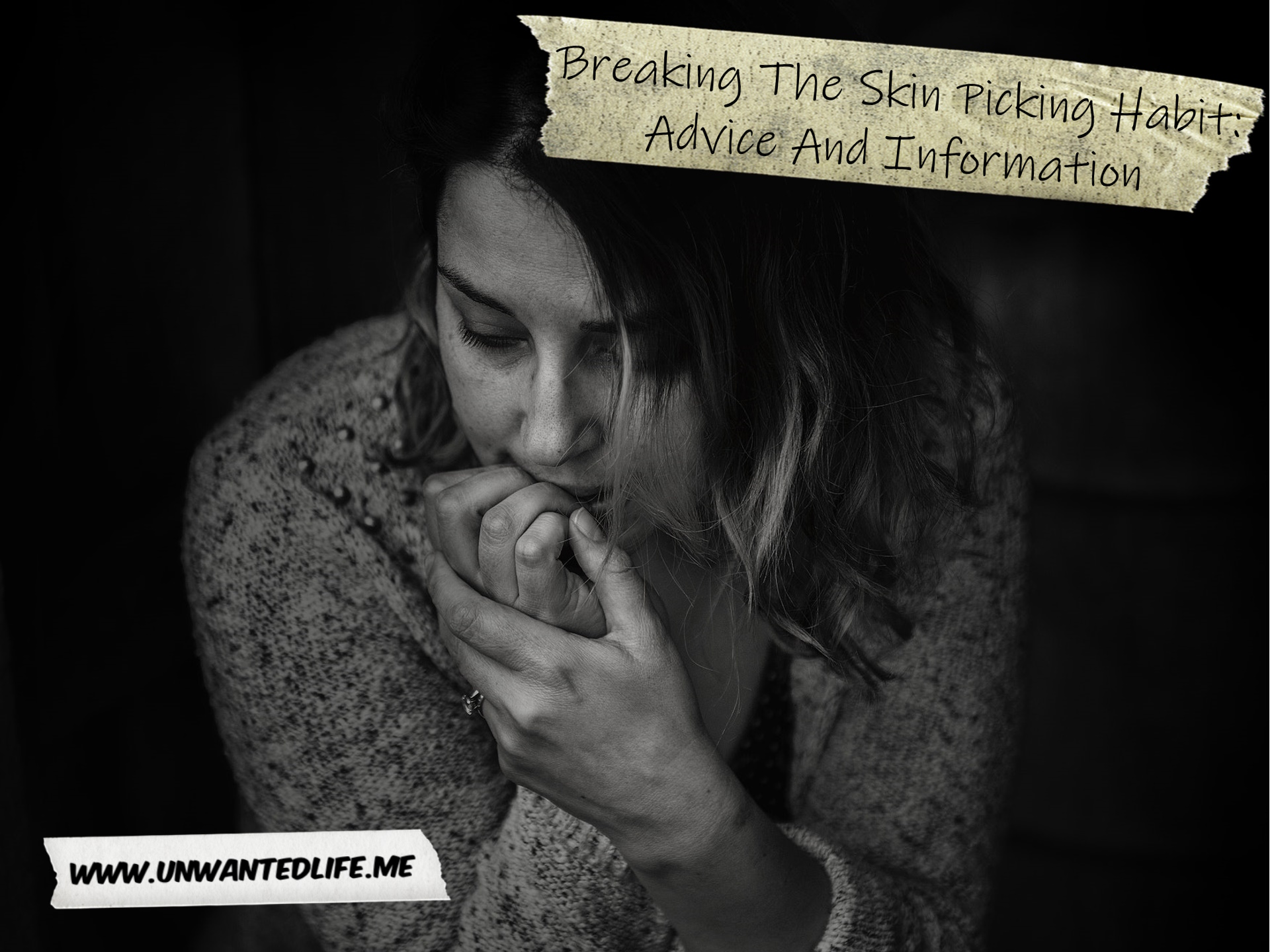The topic of skin picking has somewhat of a personal connection to me, although it’s mainly a connection to my partner. When I was younger, I’d pick the skin around my nails, but when I left my hometown, that habit subsided. It was good to be away from all that racism. However, my partner currently has issues with skin picking. Thus, it seemed like a good topic to cover today.
What Is Skin Picking
Skin picking, also known as dermatillomania or excoriation disorder, is a condition which is related to obsessive-compulsive disorder (OCD; Mental Health America). To give it its official designation, it’s an ‘obsessive-compulsive and related disorders’ (OCD UK), where you’d also find conditions like trichotillomania (Lochner, Roos, and Stein, 2017).
As the name suggests, skin picking is characterised by repeatedly picking at your own skin, which can cause the areas to swell or become broken skin (Mental Health America). This repetitive behaviour can occur anywhere on the body and across multiple sites, with the most common being the face, hands, fingers, arms, and legs (Lochner, Roos, and Stein, 2017).
However, not all people who skin pick have the skin picking disorder, dermatillomania. According to the International OCD Foundation, research has shown that many people pick at their skin from time to time. People without this disorder might pick at scabs or even healthy skin. The reason this isn’t considered a disorder is that it lacks distress or a connection to other problems in their life.
The body-focused repetitive behaviour of skin picking usually begins in adolescence, around 13-15, but it can of course occur among children and adults (Mental Health America). Some people might pick daily, while others might go through episodes with breaks in between. But left unchecked, skin picking might last years.
It should be noted that skin picking can also happen in the form of biting the skin or using some sort of tool, rather than it being as the name suggests, just picking at your skin (International OCD Foundation).
What Can Cause Skin Picking To Develop
One of the more common reasons for skin picking is because there is a minor skin irregularity (Lochner, Roos, and Stein, 2017). Think moles and skin tags, which could be a sign of issues with body image. But people can also pick out of habit (International OCD Foundation), such as one that could form out of picking at their skin irregularity.
Support for this comes from Dr Ahmed, who says underlying skin conditions like acne and eczema can lead to skin picking as a result of itching or in response to a lesion. This is further supported by Lochner, Roos, and Stein (2017) who have said the same thing.
Like with most things in life, there are many triggers for skin picking as we’re all individuals. Some people might pick at their skin as a way to cope with emotions like anxiety, anger, stress, and sadness (Lochner, Roos, and Stein, 2017; and International OCD Foundation). This is often known as emotional picking (Dr Ahmed). Although the relief they think it brings can often lead to shame and guilt.
Boredom is another potential trigger for skin picking (International OCD Foundation), which is another habitual behaviour that can form (Dr Ahmed). As well as engaging in sedentary activities like reading and watching TV (Lochner, Roos, and Stein, 2017). There are also links to intellectual disabilities and substance use and substance withdrawal (International OCD Foundation).
How To Stop Skin Picking
Therapy
According to Lochner, Roos, and Stein (2017), there are many significantly useful nonpharmacological treatments that can help with skin picking, starting with treatments like cognitive-behavioural therapy (CBT) and habit reversal therapy (HRT). HRT is a therapy designed to help people with unwanted repetitive behaviours and habits (Manhattan Psychology Group).
Support for the use of CBT and HRT in treating skin picking comes from the International OCD Foundation, which also suggests the comprehensive behavioural model (ComB). ComB therapy seeks to teach clients strategies to target problematic behaviours while addressing thoughts, feelings, and sensations that allow the habitual habit to be maintained (International OCD Foundation). All three therapies would also be good for disorders like trichotillomania.
Acceptance
As the saying goes, the first step to overcoming a problem is admitting you have one. Accepting that skin picking is a habit you have that you’d like to overcome, the easier it’ll be to tackle that problem. Much like I said in my self-acceptance article, we have to accept the good and the bad about ourselves.
Triggers
One good way to find out how best to tackle your sink picking is to identify the triggers that cause you to start skin picking. Once you’ve identified your triggers, you can then work out how to counter them. This is a task that is well suited to journaling.
Urge surfing
When it comes to substance dependency and habitual behaviours, we often experience an urge to use or to engage in habits. But the urge will eventually go on its own if you can surf that urge. To help with this, set time intervals to wait until you facilitate the urge, working up so you can wait longer and longer to do so. Eventually, you’ll find that the urge will pass before you act on the urge.
The other way to urge surf is to have things in place to help distract yourself when the urge is triggered to occupy you until it passes. You can also do a combination of the two.
Fidget toys
Because skin picking is by and large done with the fingers, giving your fingers something to do, such as a fidget toy, can be very useful in stopping. There are lots of different types of fidget toys out there, so just find one that best suits you. My preference has always been the infinity cube.
Nails
Having long nails certainly makes it easier to pick at your skin. One way to avoid this is to make sure your nails are always trimmed. Sometimes having false nails can also work.
Reduction
When I wrote my article about my hair-destroying behaviours, one of the methods I used to overcome that habit was to resist my urge to engage in my hair-destroying behaviours. I did this by allowing myself to engage in my hair-destroying behaviours, but only for a set amount of seconds. Over time I would reduce the amount of time until I no longer needed to do it. This is a harm-reduction approach to tackling this habit.

Skincare
A way to embrace the habit, but without causing harm to your skin, might be to switch the skin picking for something like applying moisturiser instead (NHS). Thus, when you get the urge to pick, you instead apply moisturiser to the area.
Gloves
Wearing gloves or putting on band-aids so your nails are covered is another simple way to help you avoid unconscious skin picking (Web MD). This option works well for mindless skin picking, which can help bring the habit to your conscious attention.
Hide
Not everyone picks at their skin with their fingers, some people often use tweezers and other such picking implements (International OCD Foundation). If this is something you do, then make sure these implements are hidden away so it makes it harder for you to engage in that behaviour. It also stops these implements from working as a prompt to pick at your skin.
Underlying causes
One of the surefire ways to rid yourself of skin picking is to treat the underlying cause. If this is a skin condition (Boots), then talking to your GP or arranging a dermatologist appointment will help with this. There are also over-the-counter treatments that could help. If the skin picking is a result of stress, anger, anxiety, etc, then working to resolve these emotional triggers will help put a stop to your skin picking.
Summary
There are many reasons why someone might start skin picking. You might also stop without having to think about it. But for those where this has become a harmful habitual behaviour, then there are many ways to break that habit and recover from the behaviour. Whatever the cause, I hope my tips prove useful if this is something you’re struggling with.
As always, leave your feedback in the comments section below. Also, please share your experiences with skin picking and how to overcome it in the comments section below as well. Don’t forget, if you want to stay up-to-date with my blog, then sign up for my newsletter below. Alternatively, get push notifications for new articles by clicking the red bell icon in the bottom right corner.
Lastly, if you’d like to support my blog, you can make a donation of any size below. Until next time, Unwanted Life readers.
References
Lochner, C., Roos, A., & Stein, D. J. (2017). Excoriation (skin-picking) disorder: a systematic review of treatment options. Neuropsychiatric disease and treatment, 1867-1872. Retrieved from https://www.tandfonline.com/doi/pdf/10.2147/NDT.S121138.


Well written. I’ve seen even famous personalities doing this when they are tense. So, after growing up, it’s more related to tension & I always believe in treating the cause.
Thanks for sharing your thoughts
I never thought about skin picking seriously but you are absolutely right that we take so many habits for granted. Visiting a dermatologist is important because sometimes unhealthy eating habits can also be the cause.
I have saved this article to share with my Mum, she often picks the skin on her arm. It began during a period of stress and she has continued the habit since. She will be glad to know she isn’t the only one who goes through this xxx
I hope your mum finds it useful
Honestly, this is something I used to do in the past but now I stopped doing it because it was getting worse. Thank you for the information!
Thanks for sharing
This is a great post! I love how researched and informative it was. I didn’t know that picking your skin could be because of other disorders. Thanks for sharing!
Thanks for commenting
Great tips! I tend to bite my nails because of anxiety- so wearing gloves really helps with that. Trying to get yourself to do something different that’s not harmful, such as applying moistursier, is a great idea too
You probably already know this, but if you’re biting your nails, putting something that tastes disgusting on and around your nails, can help with stopping that behaviour. Thanks for sharing
Thank you! That’s a great suggestion 🙂
Thanks for sharing, I tend to do this to around my nails, in moments of bordem or after filling my nails, so hopefully these tips will help me to 🙂
I hope it helps. Thanks for sharing
I have a niece who suffers from this. She picks her bottom lip due to anxiety. She is in therapy at home as well as her school offers a peer support group for students who suffer from anxiety. This is a great program that should be emulated
It’s good to see schools are taking mental health seriously. I hope your niece recovers soon
Thank you, I appreciate that. She’s doing quite well with being supported both at home and at school so she’ll be fine.
I agree with you about schools taking mental health of their students seriously. My sis appreciates it for sure
I have a child who we adopted, he is still dealing with his childhood traumas. One of the most distressing things he does as far as I’m concerned is he bites the skin around his fingers. So much so that they bleed and bleed. He is only 9. Still trying all efforts to help him stop
Hopefully, the anxiety and skin biting will disappear once they start to recover from the trauma
I’ve been doing this my whole life and never met anyone else who does! I’ve at least managed to restrict it to one side of one finger only, but I’ve never been able to drop the habit completely. Thanks for the visibility
It sounds like you’ve made some progress. I hope you’re able to completely overcome it one day
This post is really helpful as my partner does this and I have shown this blog post to them. Thank you for sharing these helpful suggestions, but also taught me more about it and why it can manifest.
Lauren – bournemouthgirl
I hope your partner ends up benefiting from reading my article. Thanks for commenting
Good post. I’ve issues with this in the past. It was a nervous reaction triggered by my anxiety. That’s why I keep my nails short and apply lots of moisturiser
I hope the steps you’ve taken are proving useful
Excellent article and a topic that is not really given much attention. Thinking about it, I do still pick at my skin from time to time, and usually at times of stress or discomfort, you have now made me aware, which I am grateful for.
Thank you for sharing